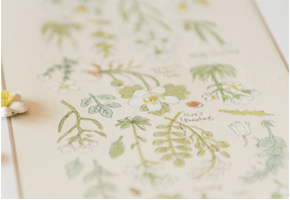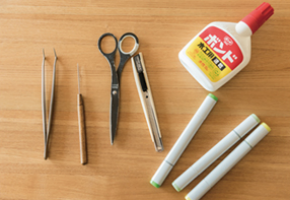
Paper quilling, roll art that depicts the four seasons
Colorful plants for all seasons created with the use of natural colors and delicate, sophisticated techniques.
Paper quilling, a traditional European craft, has witnessed a growing number of enthusiasts around the world who appreciate its wide range of techniques and variety of expressions.
Make the natural and lyrical beauty created with the unique texture of paper a part of your everyday life.
|
Paper artist Yoko KOGAMI
Born in 1976, Ms. Kogami is from Chiba. When she was working as a graphic designer at a design office, she happened to see a work by Malinda Johnston, a world-famous quilling creator, which inspired her to start her own creative pursuits. Ms. Kogami continues working actively, holding her first exhibition last May, as well as providing creative works for corporate advertisements. She is the representative of Kogami Craft and a creative adviser for Botanical Quilling Japan. |
Paper quilling is a type of craftwork in which creates parts by rolling paper cut into fine long ribbon around a needle in a spiral shape, which are then elaborately combined to create objects. The art form dates back to the 15th and 16th centuries, and is said to have originated with the decorative frames created by European nuns for religious paintings by taking the paper leftover from Bible binding and rolling it around bird feathers. This paper craft has a long history and attracts many enthusiasts, particularly in Western countries. Today it is gaining a growing number of enthusiasts in Japan as well for its simple techniques and intricate designs that resemble embroidery.
Numerous beautiful works that meticulously express the shapes and textures of the smaller parts of flowers, such as the stamens, pistils, petals, and floral axes. Taken together, the degree of perfection of these works, the delicate colors seemingly taken straight out of nature, and the elaborate designs employing the soft texture of paper is simply amazing. These works were created by Ms. Yoko KOGAMI, one of the leading Japanese paper quilling creators. Here we will explore her life history, the key areas she focuses on in her work, and her world view.
I hope to continue creating works with a keen focus on the delicate colors inherent in plants that people will want to keep looking at.
“Actually, ‘Kogami (little paper)’ is my real name,” laughs Kogami with a tinge of embarrassment. She was raised in a home that ran a newspaper shop and was influenced by a father who liked origami, or paper-folding. She was always surrounded by “paper.” “When I was a kid, I liked doing paintings and making things with my hands. Naturally, I dreamed of entering the creative world,” says Ms. Kogami. Before setting out as an artist, she majored in illustration at a special technical school and then worked as a graphic designer at a design office. Ms. Kogami says, “At that time, I dealt with mail order catalogs for sundry goods for handicrafts. One of the items introduced in those catalogs was a handmade kit for paper quilling. We needed a sample to be inserted in a magazine, so I was chosen to create the sample because I was good with my hands. It was the first time for me to try creating a paper quilling work.” The degree of perfection in Kogami’s creations was truly remarkable, and would later earn her wide acclaim. Some of the paper craft works she created eventually made the cover of a horticultural catalog magazine that she would get involved with later. She continued to create original works with seasonal motifs for a period of five years. “One day, my boss saw a growing stack of creations on my desk and suggested that I publish a basic guide to paper quilling,” recalls Ms. Kogami. “Then, we created and published a guidebook that included an introduction of how to make the basic parts, basic designs, and simple arrangements.” Ms. Kogami handled everything, from the descriptions and designs to the works introduced in the book. The publication of this book was not only effective for introducing a wider audience to paper quilling, which was still relatively unknown in Japan at that time, but also inspired her to devote more of her energy to her own creative activities.


After leaving the design office, Ms. Kogami got started as an independent creator while working as a freelance graphic designer. She continues to create many works in response to requests from companies, including public relations tools such as calendars, the covers of catalog magazines, and visual images for television commercials. In addition to these creative pursuits, Ms. Kogami works to popularize and introduce more people to paper quilling. She says “Botanical Quilling Japan was established to support quilling creators who carry out energetic creative work based on plant motifs and nurture instructors. My role in this organization is that of a creative adviser. I sincerely hope that paper quilling becomes more widely recognized as a form of art through exhibitions, the publication of collections of works, and people participating in design courses.” Ms. Kogami’s desire to elevate the value of paper quilling as an art through expressions of rich originality is steadily spreading, particularly among young creators.

Ms. Kogami’s works are characterized by natural coloring that employs natural colors free of artificial elements. “I usually create works based on a rough design drawn by on a personal computer,” she says. “I always create color samples before starting to create a form. I’m extra careful when choosing similar colors and mixing colors for each plant part. Many amateurs and other creators use color paper sold on the market and special kits, but they only allow for a limited range of colors for expression. The chief emphasis for me is to express the delicate colors of natural plants and beautiful gradations, so that’s why I do not use the color paper available on the market.” For coloring, she uses an alcohol-ink marker named COPIC, which is good for developing colors. Ms. Kogami chooses one color that she thinks is the best from among more than 350 colors, and then tries to get close to the ideal image of a particular work sometimes by painting one color on top of another. “My works produce different impressions depending on the paper I use, the remaining amount of marker ink, and the shades and shadows that form when I roll paper,” she says. Ms. Kogami’s careful attention to the creative process underlies the quality of her artwork.

①First, she creates a real-size rough design on a PC.
②Next, she prepares color samples to be used in the work in advance.

③Third, she creates the fine parts, such as the petals and floral axes, and puts them together.

④Tools used by Ms. Kogami
⑤ Kit items sold by U.S. Lake City Craft Company. Suitable for beginners.

Thickness and firmness are key factors when choosing the material. Washi is best for my works because it allows me to express the softness and texture of paper.
Ms. Kogami’s approaches her craft with an earnest desire to create overwhelming real creations that are extremely delicate and elaborate. The individual parts that make up the plants are so tiny that it’s nearly impossible to tell what they are when they fall to the floor. “Ready-made products with pre-fabricated cuts are sold on the market, such as those ones sold by Lake City Craft Company in the US, and the majority of these are three millimeters wide,” says Ms. Kogami. “I use paper 1 to 1.5 millimeters wide and start by cutting the paper by myself.” In addition, she also pays special attention to the paper used for creation. After a long process of trial and error, she decided to use the same washi (Japanese paper) used for ink-wash painting exercises. “I apply a fine level of craftsmanship to the works I create, such as in the cutting, folding, and rolling, so the firmness and thickness of paper and the blurring of ink matter,” she explains. “In addition, there is no point in doing paper quilling if you fail to express things through the use of paper. The fluffiness unique to washi, which is effective for expressing the softness and texture of paper, also matters.” Her works are so elaborate they make you feel as if they are ready to release a wave of pollen. Her creative style that is so delicate and meticulous it draws in people who appreciate her works into the world of creation.
A look at Ms. Kogami’s creative process

Use a ruler to cut washi into long and thin pieces.

Apply color to each sheet of paper with a COPIC marker.

Create fine cuts with scissors.

Roll them around a needle and glue with woodworking glue.

Spread paper cut by finger to complete the work.




The attractiveness of paper quilling lies in the capacity for people to enjoy easy creative activities that employ simple techniques. In addition, the extra element of design allows you to further expand on the ways these techniques are used. Ms. Kogami says, “Simply decorating a card sent to someone dear with paper quilling parts reveals the feelings of the creator. In addition, adding paper quilling to a photo frame for decorating photos and objet d’art also allows you to enjoy it as an accent that spruces up the room interior.” She is now working on a future concept of providing forms of art that can be incorporated within people’s everyday lives. Ms. Kogami says, “I want to create works that serve as room decorations people will always want to look at.” Introducing paper and art within the ordinary life, paper quilling expresses natural beauty that is sure to refresh and enrich the tired heart.
